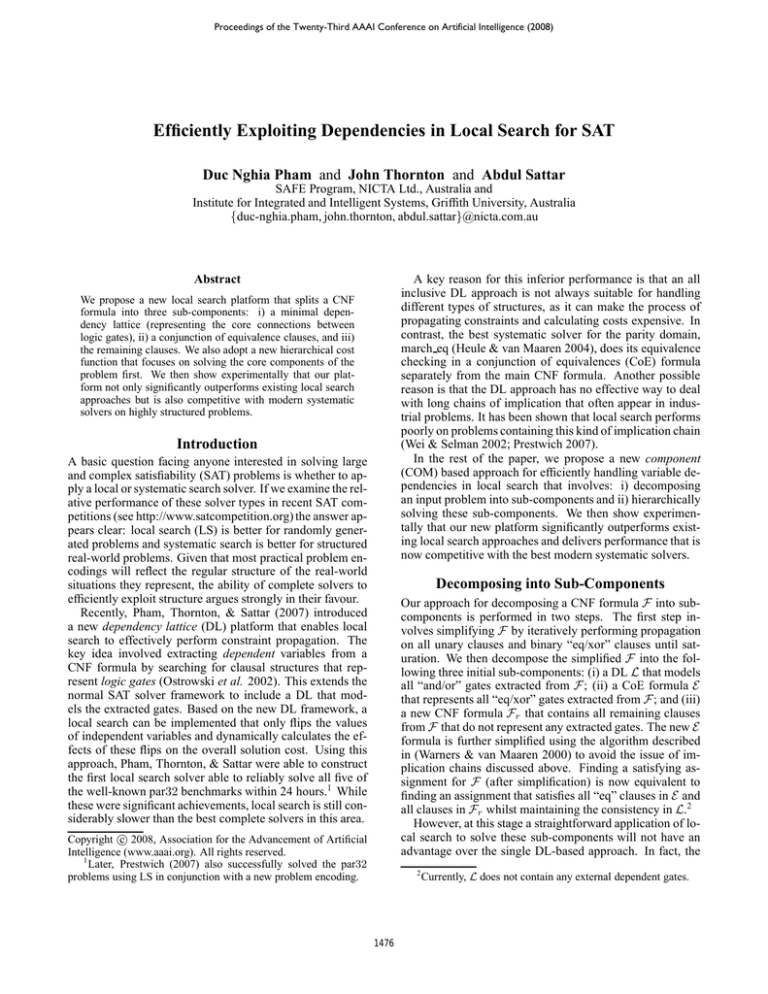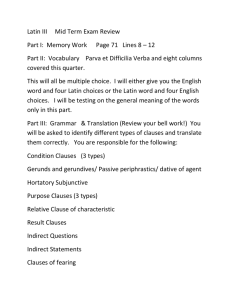
Proceedings of the Twenty-Third AAAI Conference on Artificial Intelligence (2008)
Efficiently Exploiting Dependencies in Local Search for SAT
Duc Nghia Pham and John Thornton and Abdul Sattar
SAFE Program, NICTA Ltd., Australia and
Institute for Integrated and Intelligent Systems, Griffith University, Australia
{duc-nghia.pham, john.thornton, abdul.sattar}@nicta.com.au
A key reason for this inferior performance is that an all
inclusive DL approach is not always suitable for handling
different types of structures, as it can make the process of
propagating constraints and calculating costs expensive. In
contrast, the best systematic solver for the parity domain,
march eq (Heule & van Maaren 2004), does its equivalence
checking in a conjunction of equivalences (CoE) formula
separately from the main CNF formula. Another possible
reason is that the DL approach has no effective way to deal
with long chains of implication that often appear in industrial problems. It has been shown that local search performs
poorly on problems containing this kind of implication chain
(Wei & Selman 2002; Prestwich 2007).
In the rest of the paper, we propose a new component
(COM) based approach for efficiently handling variable dependencies in local search that involves: i) decomposing
an input problem into sub-components and ii) hierarchically
solving these sub-components. We then show experimentally that our new platform significantly outperforms existing local search approaches and delivers performance that is
now competitive with the best modern systematic solvers.
Abstract
We propose a new local search platform that splits a CNF
formula into three sub-components: i) a minimal dependency lattice (representing the core connections between
logic gates), ii) a conjunction of equivalence clauses, and iii)
the remaining clauses. We also adopt a new hierarchical cost
function that focuses on solving the core components of the
problem first. We then show experimentally that our platform not only significantly outperforms existing local search
approaches but is also competitive with modern systematic
solvers on highly structured problems.
Introduction
A basic question facing anyone interested in solving large
and complex satisfiability (SAT) problems is whether to apply a local or systematic search solver. If we examine the relative performance of these solver types in recent SAT competitions (see http://www.satcompetition.org) the answer appears clear: local search (LS) is better for randomly generated problems and systematic search is better for structured
real-world problems. Given that most practical problem encodings will reflect the regular structure of the real-world
situations they represent, the ability of complete solvers to
efficiently exploit structure argues strongly in their favour.
Recently, Pham, Thornton, & Sattar (2007) introduced
a new dependency lattice (DL) platform that enables local
search to effectively perform constraint propagation. The
key idea involved extracting dependent variables from a
CNF formula by searching for clausal structures that represent logic gates (Ostrowski et al. 2002). This extends the
normal SAT solver framework to include a DL that models the extracted gates. Based on the new DL framework, a
local search can be implemented that only flips the values
of independent variables and dynamically calculates the effects of these flips on the overall solution cost. Using this
approach, Pham, Thornton, & Sattar were able to construct
the first local search solver able to reliably solve all five of
the well-known par32 benchmarks within 24 hours.1 While
these were significant achievements, local search is still considerably slower than the best complete solvers in this area.
Decomposing into Sub-Components
Our approach for decomposing a CNF formula F into subcomponents is performed in two steps. The first step involves simplifying F by iteratively performing propagation
on all unary clauses and binary “eq/xor” clauses until saturation. We then decompose the simplified F into the following three initial sub-components: (i) a DL L that models
all “and/or” gates extracted from F ; (ii) a CoE formula E
that represents all “eq/xor” gates extracted from F ; and (iii)
a new CNF formula Fr that contains all remaining clauses
from F that do not represent any extracted gates. The new E
formula is further simplified using the algorithm described
in (Warners & van Maaren 2000) to avoid the issue of implication chains discussed above. Finding a satisfying assignment for F (after simplification) is now equivalent to
finding an assignment that satisfies all “eq” clauses in E and
all clauses in Fr whilst maintaining the consistency in L.2
However, at this stage a straightforward application of local search to solve these sub-components will not have an
advantage over the single DL-based approach. In fact, the
c 2008, Association for the Advancement of Artificial
Copyright Intelligence (www.aaai.org). All rights reserved.
1
Later, Prestwich (2007) also successfully solved the par32
problems using LS in conjunction with a new problem encoding.
2
1476
Currently, L does not contain any external dependent gates.
Experimental Study
situation can get worse as these sub-components are still
tightly connected even after the decomposition (e.g. a dependent variable in L can be an independent variable in both
E and Fr ). In such cases, a local search can be easily misdirected as it has no effective way to calculate the correct cost
of flipping a variable.
Therefore, the second step of our approach attempts to
move these kinds of dependencies from E and Fr back into
L to enable constraint propagation. This is achieved as follows: for each clause c = (x1 ∨x2 ∨. . .∨xk ) in Fr , if c contains a dependent variable xi either from L or E then we add
an “or” gate v = ∨(x1 , x2 , . . . , xk ) to L and remove c from
Fr . In addition, for each dependent variable xi in E, if xi is
an input of a gate in L then we move the “eq” gate defining
xi from E to L. It should be noted that finding a satisfying
assignment for F (after simplification) is now equivalent to
finding an assignment that satisfies all “eq” clauses in E, all
clauses in Fr , and all external dependent gates in L.
To evaluate the benefits of decomposition, we compared our
new approach against the original DL-based approach reported in (Pham, Thornton, & Sattar 2007). To this end,
we used the same ssa7552, parity 16- and 32-bit SATLIB
benchmarks (available from http://www.satlib.org) reported
in the original study. It should be noted that both problem
classes decompose into only two sub-components (ssa into
a lattice Ls and a CNF formula Fs , and parity into a lattice
Lp and a CoE formula Ep ).
Table 1 compares the performance of AdaptNovelty+ and
gNovelty+ for both platforms.3 As previously discussed,
both solvers were augmented with a hard multiplier (when
solving decomposed problems) that weights in favour of satisfying external DL gates. The Table 1 results report averages for 100 runs per instance on the ssa problems (with
each run timed out after 1 hour) and 10 runs per instance on
the par32 problems (with each run timed out after 24 hours).
All experiments were performed on a machine with an AMD
Opteron 252 2.6GHz processor with 2GB of RAM.
Solving with Sub-Components
The sub-components of a problem now present a local
search solver with a set of variables, a cost calculation
mechanism and the opportunity to treat each sub-component
differently. Our approach starts with the recognition that
the lattice L represents the most tightly connected subcomponent and hence is likely to prove the most difficult
to satisfy. In addition, performing constraint propagation in
the dependency lattice is significantly more expensive than
for the E or Fr formulas. Consequently, we decided to make
it a priority to try and satisfy L by employing a hard multiplier strategy. This technique was previously used to bias a
local search to try and satisfy hard (mandatory) constraints
in over-constrained problems with hard and soft (preference)
constraints (Thornton & Sattar 1998). A static hard multiplier associates a penalty multiplier m to a subset of clauses
(known as multiplier clauses) at the start of a search. Then,
when used in conjunction with a clause weighting algorithm,
if a multiplier clause ci attracts a weight of wi during a
search then the total weight on the clause becomes m × wi .
In this way, weight is accumulated as if there were m copies
of each multiplier clause. Additional techniques exist to
dynamically alter the size of the multiplier to ensure that
the total weight of any single multiplier clause will exceed
the combined cost of all the currently false non-multiplier
clauses.
In the current work, we associated a multiplier m with
each external gate of L (these are the gates that determine the
cost of flipping an independent variable in L). While the option exists to implement a dynamic multiplier, we obtained
consistently good results from setting m equal to half the
number of non-DL clauses. We implemented the hard multiplier within two of the more successful SAT local search
solvers: AdaptNovelty+ (Hoos 2002) (as used in the original
DL study) and gNovelty+ (Pham et al. 2007) (the winner of
the random SAT category in the SAT 2007 competition). Although gNovelty+ has an additional clause weighting component, we turned this off for our experimental study, meaning the hard multiplier acted as a simple static bias towards
satisfying the DL external gates.
AdaptNovelty+
gNovelty+
Problem
#flips
#seconds
#flips
#seconds
ssa-038
2,169
2,065
15.131
0.106
1,228
1,337
2.538
0.072
ssa-158
439
430
1.203
0.002
281
285
0.235
0.001
ssa-159
460
436
1,284
1,283
n/a
214,914
n/a
2,301,746
n/a
144,026
n/a
4,626,512
n/a
45,300
1.396
0.005
292
234
0.269
0.003
5.562
0.047
956
1,062
1.240
0.039
48,194.033
34.332
13,204.536
360.955
17,766.822
22.489
9,487.728
726.010
23,212.755
7.111
109,742,764
143,743
14,289,344
476,059
57,127,508
45,733
96,051,296
3,189,435
113,712,655
11,224
25,378.797
22.800
3,329.358
73.962
13,079.765
7.151
22,187.938
494.928
26,507.983
1.748
ssa-160
par32-1
par32-2
par32-3
par32-4
par32-5
Table 1: The average performance of local search solvers on
DL−based
.
the ssa and parity problems shown in the form: COM−based
The results clearly show that the new COM-based decomposition technique produces dramatic performance benefits.
Firstly, the ssa results illustrate the greater efficiency of the
decomposition platform in terms of flip times, with each
instance solved in roughly the same number of flips using
the same algorithm, but with runtime speedups in excess
of 100. In addition, gNovelty+ is consistently better than
AdaptNovelty+ on the ssa instances, in terms of both flips
and runtimes.
The parity results exceed the general level of improvement for ssa, with the additional effect that decomposed
problems are solved in fewer flips, producing over 1, 000
times speedup on several instances. Bearing in mind that the
best existing local search solvers can only solve the par32
problems within 12 to 24 hours, these results represent a
significant breakthrough in the area.
However, our motivating question is whether a local
search approach can compete with the best complete search
3
Results on the parity 16-bit problems are omitted due to space
limitations.
1477
Solver
par32-1
AdaptNovelty+
gNovelty+
march eq
lsat
eqsatz
dew satz
par32-2
par32-3
par32-4
par32-5
the sub-component structure of the COM-based platform has
created this greater diversification and (in this case) offers an
explanation for the improved flip performance. We leave the
question as to whether this is a one-off effect for the parity
problems to further research.
In conclusion, we have extended the previous work on
dependency lattices to improve the performance of local
search on highly structured SAT CNF instances to a point
where local search is now competitive with complete search
on the well-known parity problem benchmarks. We have
shown how the work on the conjunction of equivalences
can be incorporated into a local search, and how the dependency lattice structure can be made more efficient via the
decomposition of a CNF problem into three components.
Finally, we have introduced a hard multiplier mechanism
to bias the search towards satisfying external dependency
lattice gates. In future work, there is scope to develop
more sophisticated heuristics that can handle each problem
component differently, and to implement a dynamic hard
multiplier that can adjust itself to suit the search conditions.
34.33
360.96
22.49
726.01
7.11
22.80
73.96
7.15
494.93
1.75
0.19
0.26
1.29
1.34
3.44
52.96
26.23
78.95
36.97
180.86
90.37
22.48 1, 001.57
86.79 1, 396.14
8, 603.08 3, 528.65 4, 225.39 6, 983.15 62, 636.26
Table 2: Runtimes (in seconds) of COM-based local search
solvers and systematic solvers on the parity problems.
+
+
DL−based gNovelty
COM−based gNovelty
25
8
20
6
solution costs
solution costs
7
5
4
10
5
3
2
15
0
200
400
600
search steps
800
1000
0
0
200
400
600
search steps
800
1000
Figure 1: Search costs for the par32-5 instance.
Acknowledgments NICTA is funded by the Australian
Government as represented by the Department of Broadband, Communications and the Digital Economy and the
Australian Research Council through the ICT Centre of Excellence program.
techniques when solving highly structured problems. To this
end, we solved the parity problems using four of the most effective complete solvers for this domain: march eq (Heule
& van Maaren 2004), lsat (Ostrowski et al. 2002), eqsatz
(Li 2003) and dewsatz (Anbulagan & Slaney 2005). Table 2 compares these results with the COM-based runtimes
for AdaptNovelty+ and gNovelty+. For the first time, these
local search techniques are producing runtimes comparable
with complete search. In particular, gNovelty+ achieves the
best average runtime of all the techniques considered on the
par32-5 problem and on all par16 instances. It also achieves
better runtimes than all other techniques except march eq
and lsat on the par32-2 and par32-4 instances.
References
Anbulagan, and Slaney, J. K. 2005. Lookahead saturation
with restriction for SAT. In CP-05, 727–731.
Heule, M., and van Maaren, H. 2004. Aligning CNF- and
equivalence-reasoning. In SAT-04, 145–156.
Hoos, H. H. 2002. An adaptive noise mechanism for WalkSAT. In AAAI-02, 635–660.
Li, C. M. 2003. Equivalent literal propagation in the DLL
procedure. Discrete Applied Mathematics 130(2):251–276.
Ostrowski, R.; Grégoire, É.; Mazure, B.; and Saı̈s, L. 2002.
Recovering and exploiting strutural knowledge from CNF
formulas. In CP-02, 185–199.
Pham, D. N.; Thornton, J.; Gretton, C.; and Sattar, A. 2007.
Advances in local search for satisfiability. In AI-07, 213–
222.
Pham, D. N.; Thornton, J.; and Sattar, A. 2007. Building
structure into local search for SAT. In IJCAI-07, 2359–
2364.
Prestwich, S. D. 2007. Variable dependency in local
search: Prevention is better than cure. In SAT-07, 107–120.
Thornton, J., and Sattar, A. 1998. Dynamic constraint
weighting for over-constrained problems. In PRICAI-98,
377–388.
Warners, J. P., and van Maaren, H. 2000. Recognition of
tractable satisfiability problems through balanced polynomial representations. Discrete Applied Mathematics 99(1–
3):229–244.
Wei, W., and Selman, B. 2002. Accelerating random walks.
In CP-02, 216–232.
Analysis and Conclusion
The results demonstrate, at least in the domain of the parity
problems, that techniques to assist local search to recognize
and exploit structure in CNF SAT instances can be competitive with the best complete search algorithms. The results
also show that the exclusive use of a local search dependency lattice is not necessarily optimal and that the alternative of building a minimal lattice and handling other gates
and clauses as separable components can yield dramatic performance benefits. While it is clear that the reduced size of
the DL component in our decomposition leads to significant
improvements in flip times (because the need for complex
cost propagations in the lattice is eliminated or reduced) it is
not so clear why decomposition should also reduce the number of flips needed to solve a problem. To investigate this,
we graphed the local search costs of each technique on the
par32-5 instance in Figure 1. These graphs show the number
of false clauses at each flip and illustrate a lack of diversity
in the behaviour of the DL-based runs, i.e. for most of the
time the search is alternating between cost 4 and cost 6 solutions. Conversely, the COM-based plots show the searches
visit a greater diversity of differing cost solutions. Clearly,
1478





